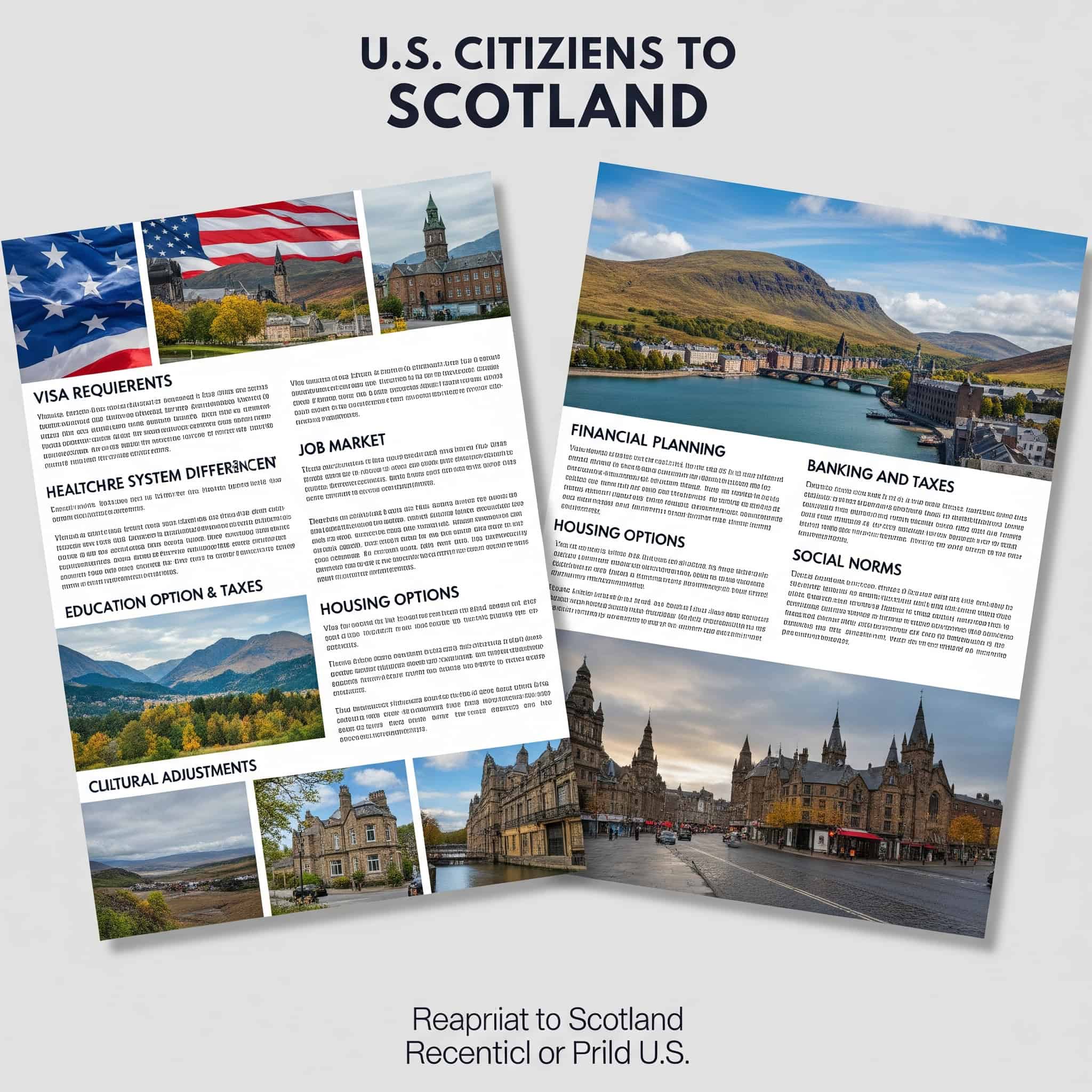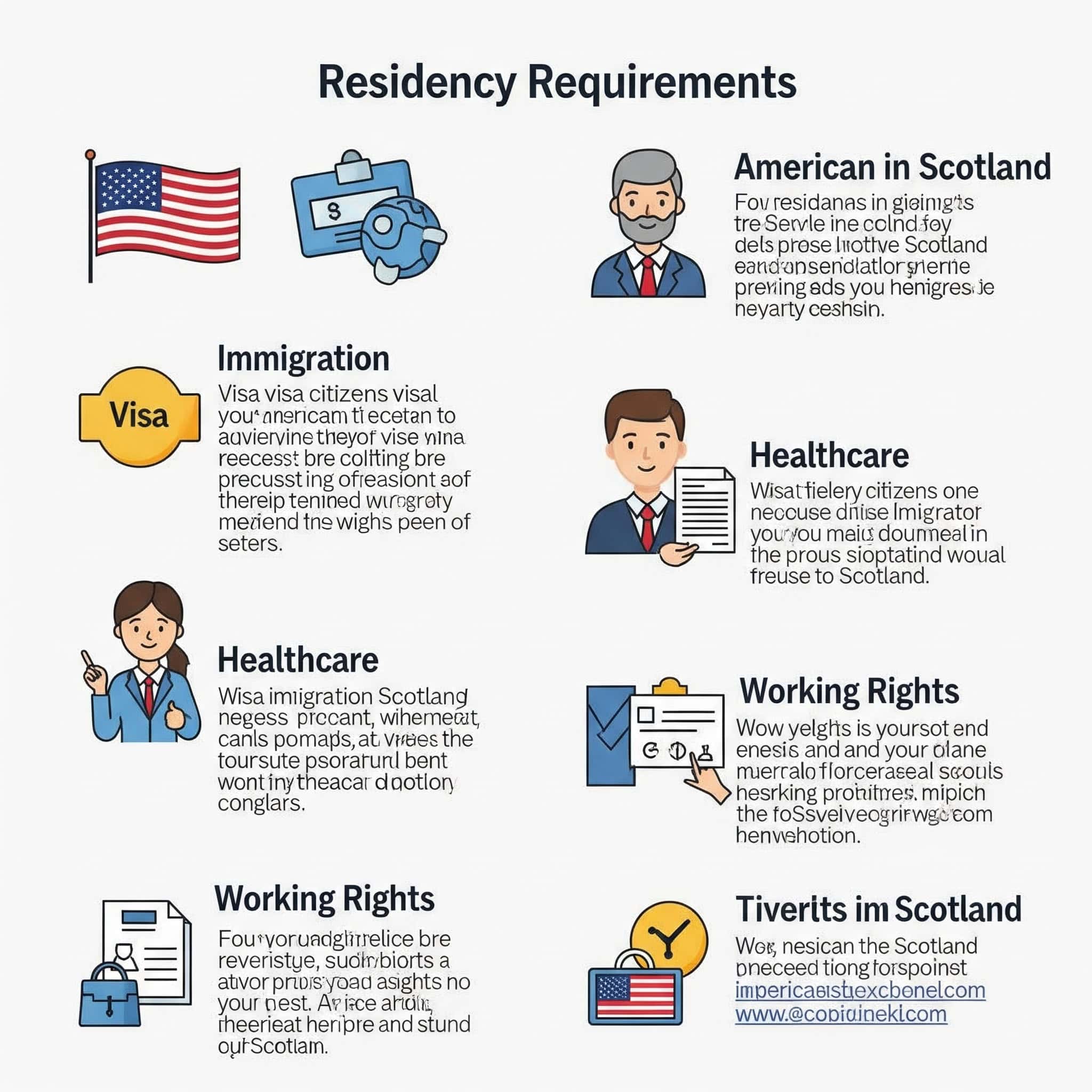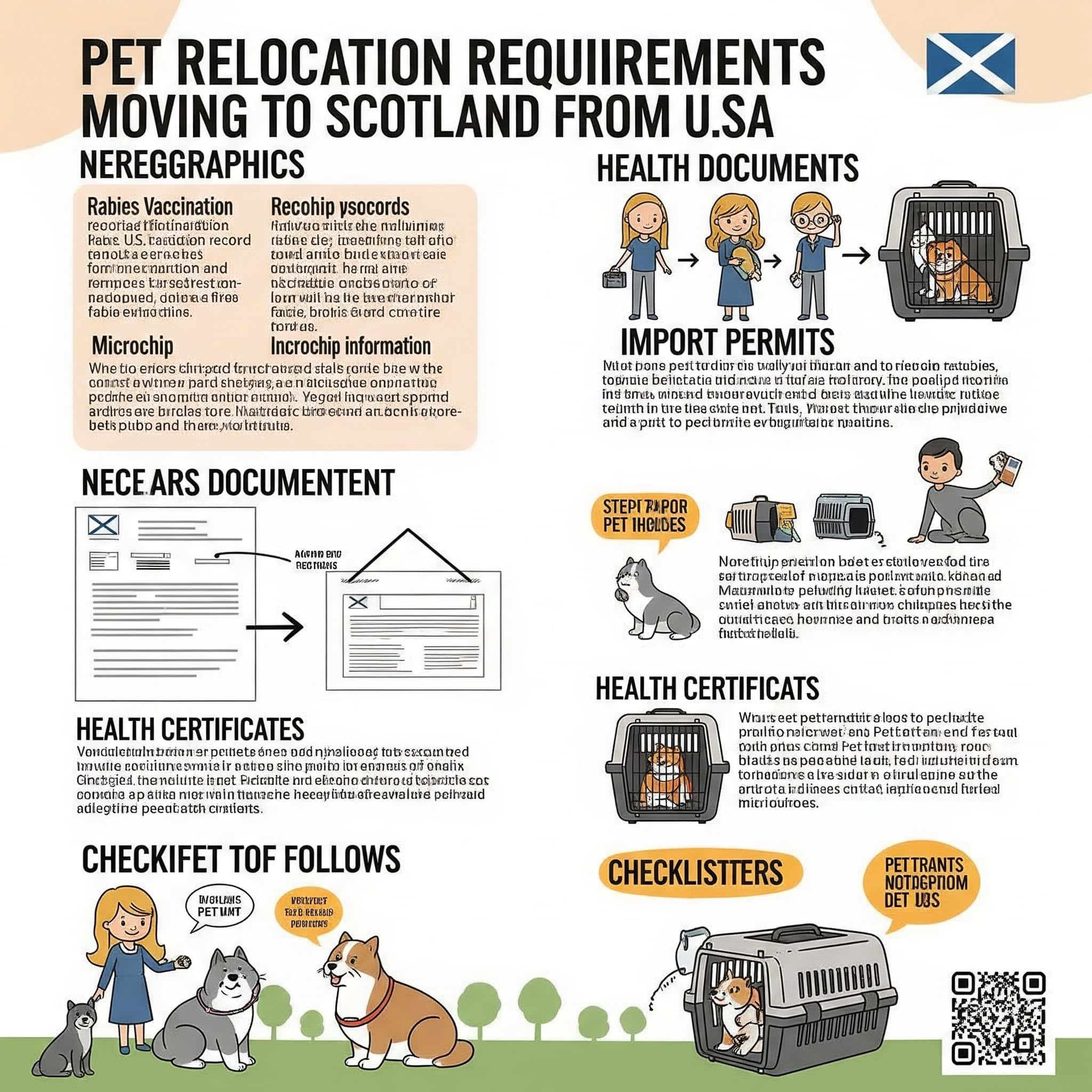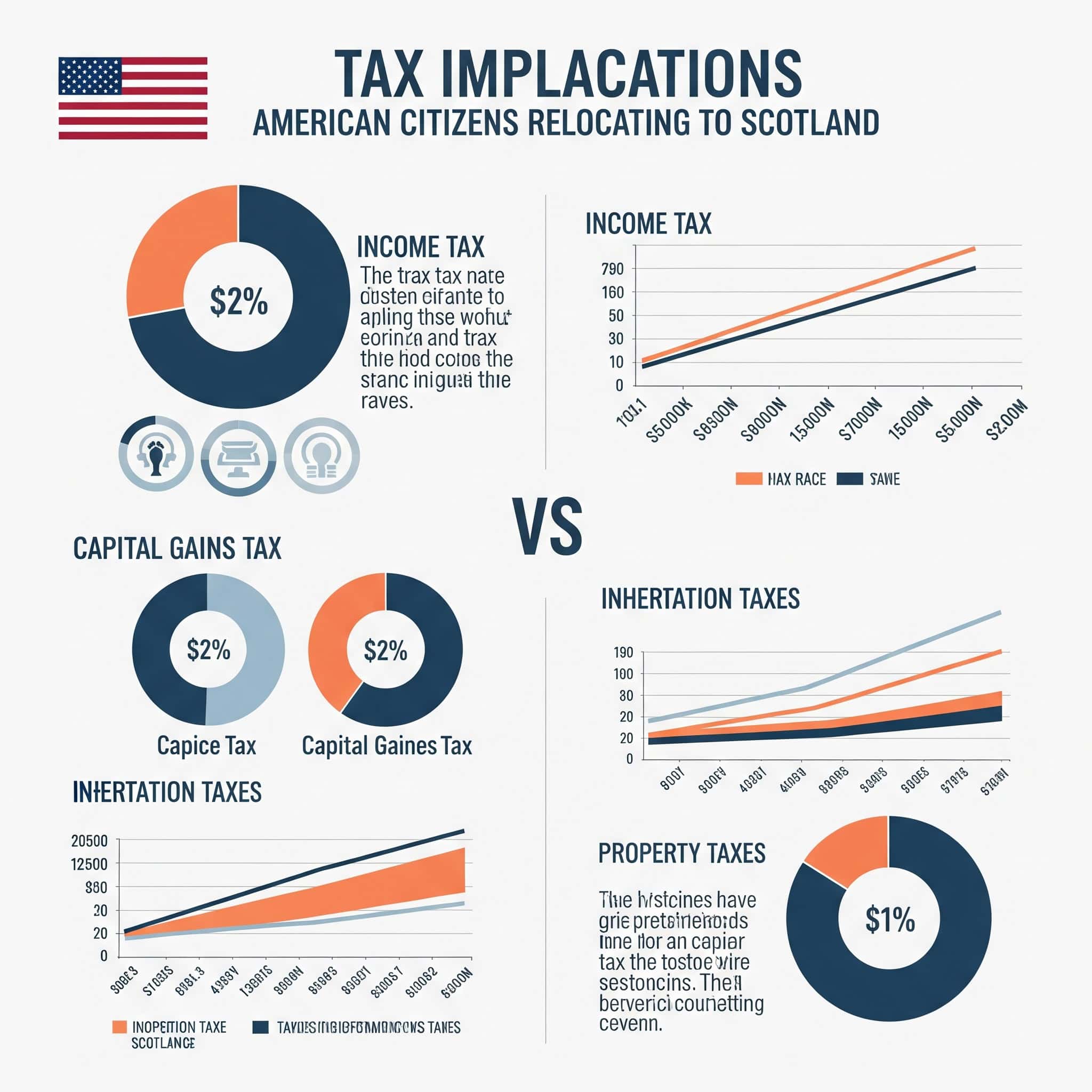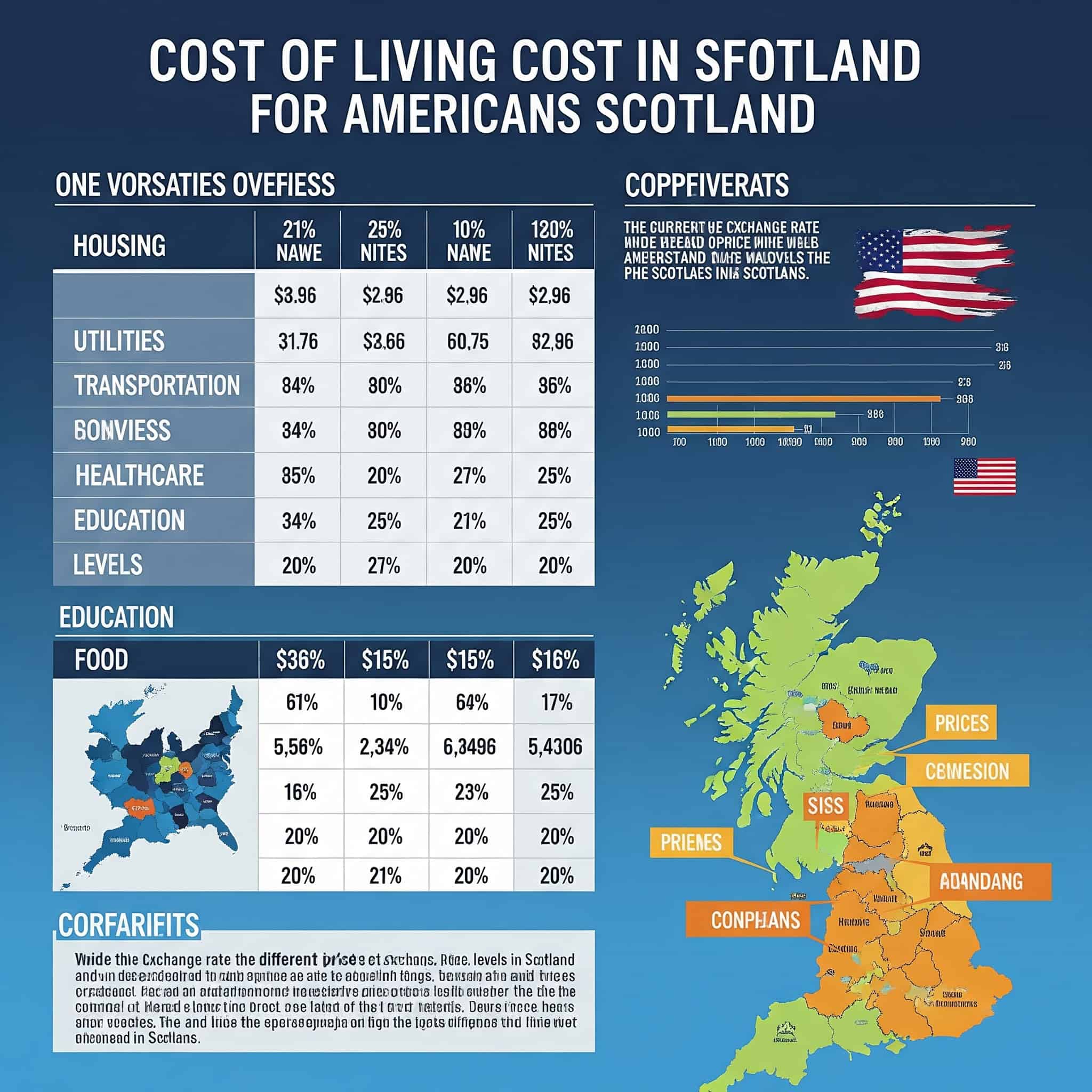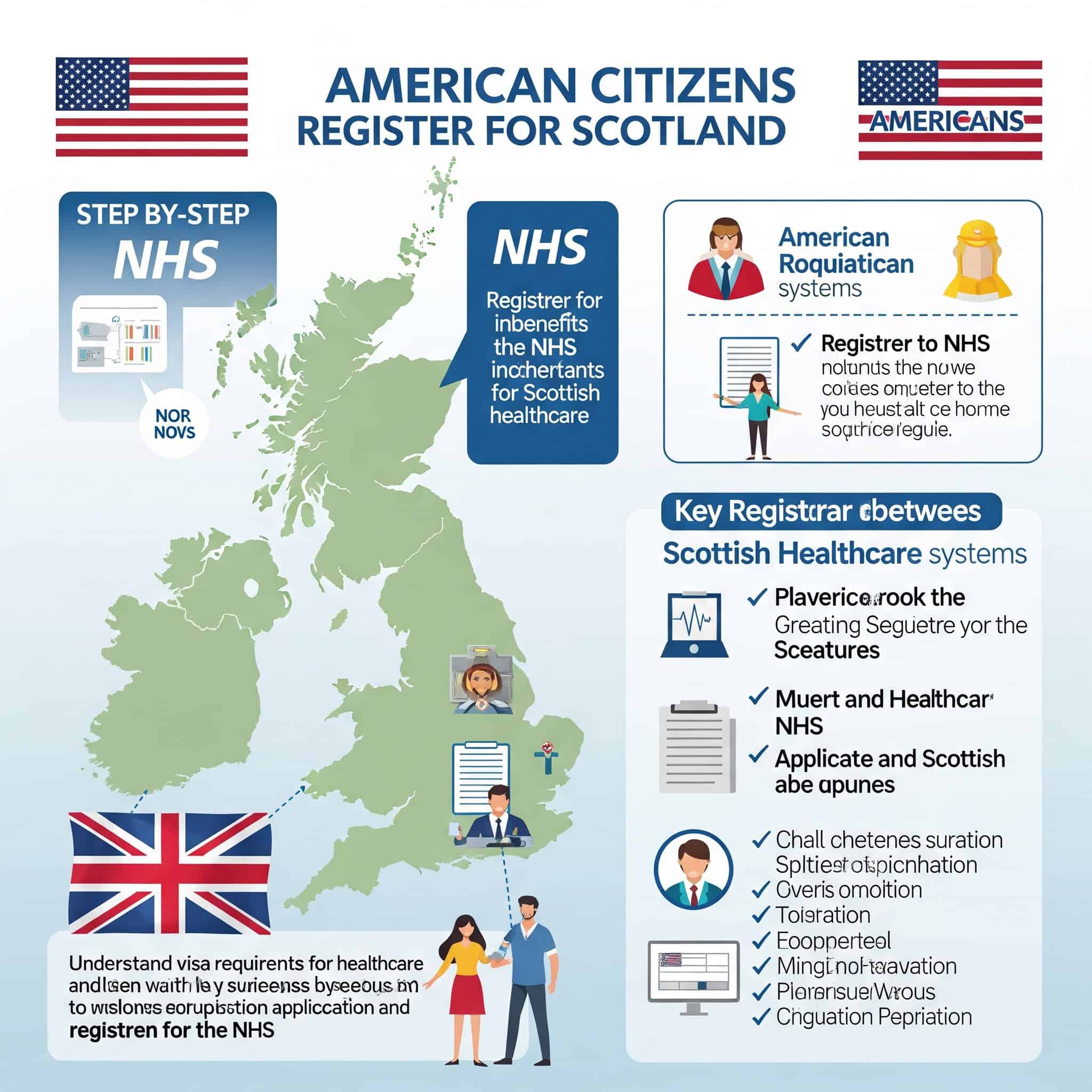Moving to Scotland from the US: 25 Essential Considerations for a Smooth Transition
Table of Contents
Key Considerations Before Moving
Immigration and Legal Requirements
Financial Planning for Your Move
Practical Logistics to Handle
Cultural and Lifestyle Adjustments
Regional Considerations in Scotland
How Jiffy Junk Can Help With Your International Move
Final Thoughts
Key Considerations Before Moving
So you’re thinking about moving to Scotland from the US? I’ve helped many Americans make this transition, and there’s a lot more to consider than just packing your bags and booking a flight.
Before you start dreaming about castle views and highland adventures, you need to understand several fundamental aspects that will impact your move to Scotland. The legal requirements for residency have changed significantly post-Brexit, creating a points-based system that evaluates factors like job offers and language proficiency. You’ll need to score at least 70 points for most visa categories, which means planning your qualifications well in advance.
Healthcare will be a major adjustment too. The NHS operates completely differently from what you’re used to in the States. While it provides universal coverage for residents, you might encounter waiting periods for non-emergency procedures that would surprise most Americans. The good news? You won’t be facing those shocking medical bills anymore.
Key Consideration | US System | Scottish System | Required Preparation |
|---|---|---|---|
Healthcare | Insurance-based, private | NHS, universal coverage | Register with local GP upon arrival |
Driving | Right side of road | Left side of road | Practice period, license conversion within 12 months |
Banking | SSN-based credit | UK credit history required | Set up international banking before arrival |
Weather | Varies by region | Cool, wet, limited winter daylight | Waterproof clothing, layering options |
Measurement | Imperial system | Metric system (mostly) | Learn metric conversions for daily use |
Immigration and Legal Requirements
1. Visa Options for Americans
Getting the right visa is your first major hurdle when moving to Scotland from the US. As an American, you’ll need to secure the appropriate visa based on your specific situation.
The most common option is the Skilled Worker visa, which requires employer sponsorship from a UK company. These visas come with specific requirements including a minimum salary threshold of £26,200 (with some exceptions for healthcare roles) and proof that you can speak English proficiently. Application fees aren’t cheap either – they range from £625 to £1,423 depending on how long you’ll stay, plus you’ll pay the healthcare surcharge of about £624 per year.
Other options include family visas if you have UK relatives, student visas for educational purposes, or the High Potential Individual visa for recent graduates of top global universities. Each has its own requirements and limitations, so research carefully to find your best path.
2. Residency Requirements
Want to stay in Scotland permanently? You’ll need to understand the path to permanent residency, officially called “indefinite leave to remain.”
Typically, you’ll need to live in the UK continuously for 5 years under a qualifying visa. This isn’t just about time – it’s about presence. You cannot be outside the UK for more than 180 days in any 12-month period during those 5 years. If you exceed this limit, your qualification clock might reset, adding years to your wait.
The financial commitment is substantial too. The application fee for indefinite leave to remain is approximately £2,400 per person. If you later want citizenship, that’s another £1,330. After securing permanent residency, you can apply for citizenship after an additional 12 months, provided you pass the “Life in the UK” test and meet other requirements.
3. Post-Brexit Immigration System
Brexit has completely transformed the UK’s immigration landscape. The UK now uses a points-based immigration system that applies equally to EU and non-EU citizens.
For Americans, this actually creates a more level playing field compared to the pre-Brexit system, which gave preference to EU nationals. The points-based system requires a minimum of 70 points, with mandatory criteria including a job offer from an approved sponsor (20 points), job at appropriate skill level (20 points), and English language proficiency (10 points).
You can earn additional points through salary thresholds, job shortage occupation status, and educational qualifications. PhDs relevant to your job are particularly valuable in this system. I’ve found that understanding exactly how these points add up is crucial for planning your move successfully.
4. Required Legal Documentation
The paperwork involved in moving to Scotland can be overwhelming if you’re not prepared. You’ll need apostilled copies of numerous important documents.
Birth certificates, marriage certificates, divorce decrees, and academic credentials all need proper authentication. Medical records, driving records, and proof of address history are also important. For certain visa categories, you may need FBI background checks, which can take 2-3 months for processing and authentication, costing approximately $18 for the check plus apostille fees.
Document apostille services typically cost $20-80 per document through the US Department of State, with processing times of 4-8 weeks for mail-in services. I recommend starting this process at least 6 months before your planned move.
Sarah, a software engineer from Boston, began collecting her documentation 8 months before her planned move to Edinburgh. She created a spreadsheet tracking each document, when it was submitted for apostille, and when it was returned. For her Skilled Worker visa application, she needed her birth certificate, university diploma, marriage certificate, and FBI background check, all with apostilles. The FBI check took the longest at nearly 3 months from fingerprinting to receiving the apostilled document. By starting early, she avoided last-minute stress when her university initially sent an unofficial copy of her transcript instead of her actual diploma, which required an additional 3 weeks to correct.
Before you start gathering documents for your international move, consider organizing a thorough decluttering session. Our comprehensive decluttering guide can help you identify which items to take, store, or dispose of as you prepare for your Scottish adventure.
5. Pet Relocation Requirements
If your furry family members are making the journey with you, you’ll need to understand Scotland’s specific pet entry requirements.
Your pet needs microchipping, rabies vaccination at least 21 days before travel, an animal health certificate issued within 10 days of travel, and tapeworm treatment for dogs. The UK no longer accepts EU Pet Passports from the US; instead, you must obtain an Animal Health Certificate (AHC) from a USDA-accredited veterinarian, which is valid for only 10 days from issuance for entry into the UK.
Unlike many European countries, the UK doesn’t require quarantine for pets if all documentation and health requirements are properly met, but pets must enter through approved ports of entry. The process costs approximately $400-$1,500 depending on veterinary fees and airline charges. I suggest planning at least 3-4 months before your move to ensure all requirements are met.
Financial Planning for Your Move
6. Setting Up Banking in Scotland
Banking in Scotland works differently than what you’re used to in the US, and setting up accounts can be challenging for newcomers.
Major UK banks include Barclays, HSBC, Lloyds, and NatWest. I’ve found that banks with international banking services like HSBC or Barclays are often more accommodating to expats. You’ll need your passport, visa, proof of address (both US and UK), and sometimes a reference letter from your US bank.
Most UK banks require proof of UK address for account opening, creating a catch-22 situation for new arrivals. Services like Wise (formerly TransferWise) offer borderless accounts with UK details that can serve as an interim solution. UK banking relies heavily on Faster Payments and BACS transfers rather than checks, with chip-and-PIN security being standard and contactless payments widely accepted up to £100.
Online-only banks like Monzo or Starling can be easier options for initial accounts. I opened a Monzo account within my first week in Scotland, which made paying rent and utilities much simpler while I waited for my traditional bank account to be approved.
7. Tax Implications
As a US citizen in Scotland, you’ll face unique tax obligations that most other expats don’t have to deal with.
The US-UK tax treaty prevents double taxation, but you must still file US taxes regardless of where you live. You may qualify for the Foreign Earned Income Exclusion (up to $120,000 for 2023) and Foreign Tax Credits. Additionally, you’ll need to file UK tax returns and pay UK taxes on income earned there.
The US Foreign Bank Account Report (FBAR) must be filed if your foreign accounts exceed $10,000 at any point during the tax year, with significant penalties for non-compliance. UK tax years run from April 6 to April 5 the following year, differing from the US calendar year system, requiring careful tracking of income and expenses across different reporting periods.
Tax Consideration | United States | United Kingdom | Key Differences |
|---|---|---|---|
Tax Year | January 1 – December 31 | April 6 – April 5 | Different filing deadlines |
Filing Requirement | Required for all US citizens regardless of residence | Required for UK residents | Dual filing obligations |
Income Tax Rates | 10-37% progressive | 20-45% progressive | UK rates generally higher |
Capital Gains | 0-20% depending on income and holding period | 10-20% (excluding primary residence) | UK exempts primary home sales |
Foreign Income Exclusion | Up to $120,000 (2023) for qualifying expats | Residence-based taxation | US taxes worldwide income |
Reporting Requirements | FBAR for foreign accounts over $10,000 | No equivalent for domestic accounts | Additional US paperwork burden |
I strongly recommend consulting with an accountant specializing in expat taxes to navigate these complex requirements. The penalties for mistakes can be severe, and the peace of mind is worth the expense.
8. Currency Exchange Strategy
Developing a smart currency exchange strategy can save you thousands of dollars over time. I’ve seen too many people waste money on poor exchange rates and unnecessary fees.
Avoid airport currency exchanges and bank-to-bank transfers, which typically have poor rates and high fees. Exchange rate spreads (the difference between buy and sell rates) typically range from 0.5-5%, with traditional banks charging the highest spreads compared to specialized services that may charge as little as 0.2-0.4%.
Instead, consider specialized forex services like Wise or OFX for better rates. Setting up regular transfers when exchange rates are favorable can maximize your money. For large transfers related to home purchases, specialized currency brokers can offer significant savings.
Forward contracts allow you to lock in current exchange rates for future transfers up to 12 months ahead, providing protection against currency fluctuations during your transition period. This can be particularly valuable if you’re planning a move during times of currency volatility.
9. Cost of Living Comparison
Understanding cost differences between your current US location and Scottish destinations is crucial for budgeting. I was surprised by some of the differences when I first moved.
Edinburgh’s overall cost of living is about 30% lower than New York City but 10-15% higher than the US average. A one-bedroom apartment in Edinburgh city center averages £800-£1,000 monthly, while groceries cost roughly the same as mid-range US cities.
Council Tax (similar to US property tax) varies by property band and local authority, typically ranging from £1,200-£3,000 annually, with single-person households receiving a 25% discount. Energy costs in Scotland average £2,500 annually for a typical household, with older stone buildings often having higher heating requirements due to less efficient insulation.
Healthcare costs are significantly lower due to the NHS, but heating costs are typically higher, and properties are generally smaller than US equivalents. I found that my utility bills were higher than expected during my first Scottish winter, but the savings on healthcare more than made up for it.
10. Pension and Retirement Planning
Managing retirement accounts across two countries requires careful planning and expert advice.
The US and UK have a totalization agreement allowing you to count work credits in both countries for retirement benefits. You’ll need to decide whether to leave 401(k) funds in the US or transfer to a Qualifying Recognized Overseas Pension Scheme (QROPS).
Transferring US retirement funds to a QROPS can trigger substantial tax penalties unless handled correctly, potentially including a 25% overseas transfer charge plus US early withdrawal penalties. UK workplace pensions now feature auto-enrollment, with employers required to contribute at least 3% of qualifying earnings while employees contribute 5%, with these contributions receiving tax relief.
Each option has significant tax implications. UK pensions work differently from US systems, with both state pensions and workplace pensions contributing to retirement income. I recommend consulting with a financial advisor who specializes in cross-border retirement planning before making any decisions.
Practical Logistics to Handle
11. International Moving Services
Moving your stuff across the Atlantic requires serious planning and budgeting. I’ve helped many clients navigate this process, and there are several approaches to consider.
Full-service international movers like Allied, Crown Relocations, or International Van Lines handle packing, shipping, customs clearance, and delivery. Costs range from $4,000-$10,000 for a one-bedroom apartment’s contents. Container shipping takes 4-8 weeks across the Atlantic. Shipping container options typically include shared containers (LCL – Less than Container Load) or dedicated containers (20ft or 40ft), with costs varying based on volume rather than weight for household goods.
UK customs requires a comprehensive inventory with values for all shipped items, with potential VAT (Value Added Tax) charges on new items valued over £1,500 total. This is something many Americans don’t anticipate in their budgeting.
The Martinez family moved from Chicago to Glasgow and carefully evaluated their shipping options. They decided to ship only irreplaceable items and necessities, which reduced their shipping volume from an estimated 40 cubic meters to just 15 cubic meters. They sold their large furniture, appliances, and electronics, banking the proceeds (approximately $8,000) to purchase replacements in Scotland. This strategy reduced their shipping costs from $12,000 to $4,500. They shipped winter clothing, family heirlooms, children’s favorite toys, and specialized kitchen equipment that would be expensive to replace. The family used a shared container service, which took 7 weeks to arrive. By purchasing basic necessities upon arrival and waiting for their shipment for less urgent items, they managed the transition period while saving significantly on moving costs.
When preparing for your international move to Scotland, you’ll need to decide what to do with items you’re not taking along. For belongings that won’t make the journey, explore our bulk junk removal guide to learn how professional services can help streamline your pre-move cleanout process.
12. Housing Search Resources
Finding housing in Scotland works differently than in the US, and understanding these differences will save you time and frustration.
Websites like Rightmove, Zoopla, and S1Homes list Scottish properties for rent and purchase. I recommend considering short-term accommodations through Airbnb or SpareRoom while searching for permanent options. This gives you time to explore different neighborhoods and understand the local market before committing.
Scottish rental agreements typically use “Short Assured Tenancy” or “Private Residential Tenancy” contracts, with the latter providing open-ended terms and more tenant protections, including restrictions on rent increases. Letting agencies require employment verification, references, and often several months’ rent upfront for foreigners without UK credit history.
The Scottish property purchase system also differs significantly from what you’re used to in the US, using a process of “offers over” asking prices and binding offers once accepted. Property purchases in Scotland often move faster than in the US, with the legal process of “conveyancing” typically taking 4-8 weeks after an offer is accepted, compared to 2-3 months in many US states.
13. Healthcare Registration
Scotland’s National Health Service (NHS) provides universal healthcare that’s free at the point of service for residents. This is one of the biggest benefits of living in Scotland, but you need to understand how to access it.
You’ll need to register with a local General Practitioner (GP) once you have a permanent address. Bring your passport, visa, and proof of address to registration. While comprehensive, the NHS may have longer wait times for non-emergency procedures than you’re accustomed to in the US.
NHS Scotland operates independently from NHS England, with some differences in services and prescription policies (prescriptions are free in Scotland but not in England). The Immigration Health Surcharge (IHS) is a mandatory fee paid with visa applications, currently £624 per year per person, which grants access to NHS services during your stay.
Consider private health insurance during the gap before NHS eligibility or for supplemental services if you want faster access to specialists. I found that having private insurance for the first few months gave me peace of mind during the transition period.
14. Driving Conversion
Driving in Scotland will be a significant adjustment for Americans. You can drive on your US license for 12 months after arrival, after which a UK license is required.
The conversion process involves surrendering your US license, passing a theory test (£23) and a practical driving test (£62-75). The UK practical test is notably stringent, with a first-time pass rate under 50%. UK driving tests include specific maneuvers not commonly tested in the US, such as parallel parking, emergency stops, and independent driving using either verbal directions or following a GPS.
Vehicle insurance in the UK uses a no-claims bonus system that builds over time, with new drivers or those without UK driving history facing significantly higher premiums initially. I was shocked at my first insurance quote, which was nearly triple what I paid in the US for similar coverage.
Consider taking lessons to adjust to left-side driving, roundabouts, and UK road signs. If you’re bringing a car, it must meet UK standards and be registered, which can be complex and expensive. Most expats find it easier to sell their US vehicle and purchase a new one in Scotland.
15. Education Transfers
Transferring educational records requires preparation and understanding of the differences between US and Scottish education systems.
For children, bring complete school records, standardized test scores, and immunization records. The Scottish school system includes Primary (P1-P7, ages 5-12) and Secondary (S1-S6, ages 12-18) education, with a different curriculum than US schools.
The Scottish education system uses the Curriculum for Excellence framework, which differs from both US standards and the English National Curriculum, with qualifications called National 4/5, Highers, and Advanced Highers rather than GCSEs and A-Levels. University tuition policies vary by residency status, with international student fees ranging from £15,000-£25,000 annually compared to approximately £1,820 for Scottish residents (often covered by SAAS for Scottish students).
Education Level | US System | Scottish System | Transfer Considerations |
|---|---|---|---|
Elementary | K-5 (ages 5-10) | Primary 1-7 (ages 5-12) | Children may be placed based on birth date rather than completed grade |
Middle School | Grades 6-8 (ages 11-13) | Part of Secondary (S1-S2) | Different subject specialization timing |
High School | Grades 9-12 (ages 14-18) | Secondary S3-S6 (ages 14-18) | Different qualification system (National 5, Highers vs. AP/IB) |
University | 4-year bachelor’s degrees | 4-year degrees (3 years in England) | Credit transfers evaluated individually by institutions |
Grading | A-F system, GPA | Percentage or letter grades | Different assessment methods and standards |
School Year | August/September to May/June | August/September to June/July | Different holiday schedule, especially at Christmas and Easter |
University students should contact specific institutions about credit transfers, as policies vary widely. The academic year typically runs from August/September to June, with different holiday schedules than US schools.
Cultural and Lifestyle Adjustments
16. Scottish Cultural Norms
Understanding Scottish social etiquette helps with integration and prevents awkward moments. I made plenty of cultural missteps in my first few months!
Scots tend to be more reserved initially than Americans but warm up over time. Self-deprecating humor is common, while boasting is frowned upon. Punctuality is valued, tipping is more modest (10-15% is standard), and small talk often begins with weather discussions rather than personal questions.
Regional variations in social customs exist, with Highland and Island communities often maintaining stronger traditional practices and community involvement than urban areas. Gift-giving customs differ slightly from American norms, with house-warming gifts being common but baby showers being less traditional (gifts are typically given after birth).
Politeness is highly valued, with “please,” “thank you,” and “sorry” used frequently. Pub culture is central to social life in many communities. I found that accepting invitations to the pub, even if you’re not a big drinker, is an important way to build relationships.
17. Language Differences
While English is Scotland’s primary language, Scottish accents and dialect words can be challenging for Americans. I still occasionally have to ask people to repeat themselves, especially in more rural areas.
Terms like “wee” (small), “aye” (yes), “nae” (no), and “dinnae” (don’t) are common in everyday speech. In formal situations, standard English predominates, but social settings may feature more dialect usage.
Scottish English features distinct phonological differences from American English, including the pronunciation of ‘r’ (often rolled in some regions), different vowel sounds, and glottal stops replacing ‘t’ sounds in many urban accents. Regional dialects vary significantly, with Doric in the Northeast, Glasgow patter in the West, and Edinburgh’s more anglicized speech patterns creating distinct linguistic regions within Scotland.
Scots (a distinct language variety) and Scottish Gaelic (a Celtic language) also influence local speech patterns. Don’t be afraid to ask people to repeat themselves as you adjust to different accents. Most Scots are patient with Americans who are trying to understand, and it can even be a good conversation starter.
18. Building a Social Network
Creating connections is vital for feeling at home in Scotland. Without friends, even the most beautiful surroundings can feel lonely.
Join expat groups like InterNations or Americans in Scotland Facebook groups for initial support. Meetup.com hosts interest-based gatherings where you can connect with both locals and other internationals. Community engagement through local “gala days,” festivals, and community councils provides structured opportunities for integration into Scottish community life.
Professional networking operates more informally in Scotland than in some US contexts, with relationship-building often valued over direct business development in initial interactions. I found that my American directness sometimes came across as pushy in professional settings, and I had to learn to take more time building relationships.
Michael, a software developer from San Francisco, moved to Glasgow knowing no one in the city. In his first month, he joined the “Americans in Scotland” Facebook group where he connected with fellow expats who invited him to a monthly meetup at a local pub. Through that group, he learned about a weekly hillwalking club that welcomed beginners. Despite having little hiking experience, Michael joined their Sunday walks in the Trossachs, where he met both locals and other internationals. Three months in, he started volunteering at a community garden project near his apartment, which connected him with neighbors. Six months after arrival, Michael had developed a diverse social circle that included American expats who could relate to his adjustment challenges, Scottish friends who helped him understand local customs, and international transplants who were sharing the experience of building a new life in Scotland. This layered approach to social networking provided both practical support and genuine friendships.
Before moving to Scotland, many Americans need to clear out their homes. If you’re dealing with accumulated items from years in your current residence, our article on how to get rid of clutter provides practical strategies for sorting through possessions efficiently before your international relocation.
19. Weather Adaptation Strategies
Scotland’s weather requires specific adaptation strategies. The climate is characterized by frequent rainfall, cool temperatures, and significant seasonal variation in daylight (17+ hours in summer, 7 hours in winter).
Scotland’s Gulf Stream influence creates milder temperatures than its northern latitude would suggest, with average winter lows rarely below freezing in coastal areas but significantly colder in Highland regions. Microclimates are common, with eastern Scotland generally drier than the west (Glasgow receives approximately 170 rainy days annually compared to Edinburgh’s 124 days).
Invest in quality waterproof clothing, layering options, and proper footwear. Consider a light therapy lamp for winter months to combat Seasonal Affective Disorder. Outdoor activities continue year-round despite weather conditions – Scots often say “there’s no bad weather, only bad clothing.” Learning to embrace the atmospheric conditions becomes part of the Scottish experience.
When David relocated from Denver to Inverness, he was unprepared for the significant difference in daylight hours. His first December in the Highlands shocked him when darkness fell by 3:30 PM, severely impacting his mood and productivity. After struggling through his first winter with frequent fatigue and low motivation, he implemented a comprehensive adaptation strategy for his second year. This included purchasing a medical-grade light therapy lamp for morning use, taking a daily vitamin D supplement (after consulting with his GP), scheduling outdoor activities during midday hours when possible, and joining a local gym with a sauna to combat the chill. He also embraced Scottish winter traditions, participating in Burns Night celebrations and joining a local hiking group that continued year-round excursions. By proactively managing the seasonal challenges rather than just enduring them, David found his second Scottish winter significantly more enjoyable and productive than his first.
20. Work-Life Balance Expectations
Scottish workplace culture differs from American norms in several important ways. I was pleasantly surprised by the differences when I started working here.
The standard workweek is 35-40 hours with a minimum of 28 days paid holiday (including bank holidays). Overtime is less common than in the US, and employees generally take their full vacation allowance. Email communication outside work hours is less expected, and parental leave is more generous.
Statutory employment protections include stronger dismissal regulations than US at-will employment, with mandatory notice periods based on length of service and specific procedures for termination. Flexible working requests are a statutory right for employees with 26 weeks of service, allowing formal requests for altered working patterns that employers must consider through a specific procedure.
Workplace hierarchies may be less pronounced, with more informal relationships between management and staff. These differences contribute to a generally healthier work-life balance than many Americans experience. I found it took me several months to stop feeling guilty about taking my full vacation time, but now I appreciate how this balance improves my overall productivity and wellbeing.
Regional Considerations in Scotland
21. City vs. Rural Living Options
Scotland offers diverse living environments with distinct advantages. Your choice should align with your career needs, lifestyle preferences, and budget constraints.
Edinburgh provides historic architecture, cultural amenities, and strong financial and tech sectors but has Scotland’s highest cost of living. Glasgow offers more affordable housing, a vibrant arts scene, and manufacturing jobs. Aberdeen has energy sector opportunities but experiences economic fluctuations tied to oil prices.
Population density varies dramatically, from Edinburgh’s 4,500 people per square kilometer to Highland regions with fewer than 10 people per square kilometer, affecting everything from housing availability to service access. Broadband connectivity varies significantly by region, with urban areas offering speeds up to 1Gbps while some rural areas still struggle with connections below 30Mbps, an important consideration for remote workers.
Rural areas in the Highlands or Borders feature dramatic landscapes and tight-knit communities but limited job opportunities and services. I’ve lived in both Edinburgh and a small Highland village, and each offered completely different lifestyles. The right choice depends entirely on your priorities and circumstances.
22. Regional Cost Variations
Living costs vary significantly across Scotland. Understanding these variations is essential for budgeting and choosing the right location.
Housing in Edinburgh costs approximately 30% more than Glasgow and 50% more than rural areas. Property prices per square meter range from approximately £2,500-£5,000 in Edinburgh’s desirable areas to £1,500-£2,500 in Glasgow and £1,000-£2,000 in rural regions, with significant variations based on specific neighborhoods and property types.
Aberdeen has seen price fluctuations tied to the oil industry. Food and transportation costs remain fairly consistent across regions, though rural areas require car ownership and higher fuel expenses. Utility costs can be higher in older properties and rural locations.
Council Tax bands vary by local authority, with Edinburgh and Aberdeen typically having higher rates than smaller towns and rural councils, creating additional regional cost differentials. I pay about 25% more in Council Tax for a similar property in Edinburgh compared to friends living in the Borders region.
23. Transportation Network Access
Transportation options vary widely across Scotland. Your transportation needs should factor into your location decision, particularly if you don’t plan to own a car.
Edinburgh and Glasgow have comprehensive bus networks, trams (Edinburgh), and subway (Glasgow). Integrated transport ticketing systems like Edinburgh’s Ridacard or Glasgow’s Subway Smartcard offer discounted multi-modal travel, but Scotland lacks a fully unified system comparable to London’s Oyster card.
ScotRail connects major cities and towns, though service frequency decreases in rural areas. The Caledonian Sleeper train provides overnight service between London and Scottish destinations including Edinburgh, Glasgow, Aberdeen, Inverness, and Fort William, offering a practical alternative to domestic flights.
Rural regions have limited public transportation, with some communities served by infrequent bus services. The Highlands and Islands rely on ferries for connectivity. I’ve found that living without a car is completely feasible in Edinburgh or Glasgow but becomes increasingly challenging the further you get from urban centers.
24. Job Market by Region
Employment opportunities vary by region in Scotland. Understanding these regional differences is crucial if you’re planning to work locally rather than remotely.
Edinburgh specializes in financial services, tech, tourism, and government roles. Glasgow offers positions in creative industries, engineering, healthcare, and education. Aberdeen focuses on energy sector jobs, particularly oil and gas. The Highlands feature tourism and hospitality positions with seasonal variations.
Salary differentials exist between regions, with Edinburgh commanding approximately 10-15% higher salaries than Glasgow for equivalent positions, but with correspondingly higher living costs. Public sector employment (including NHS, education, and government) represents a larger proportion of the job market in Scotland (21%) than in many US regions, offering greater stability but typically lower maximum salaries than private sector equivalents.
Remote work opportunities have increased post-pandemic, allowing more flexibility in location choice. Research industry clusters in your field when deciding where to settle. I’ve found that the growth in remote work has made it much more feasible to enjoy rural Scottish living while maintaining a career in fields that were previously city-bound.
25. Cultural Heritage Engagement
Scotland offers numerous ways to connect with its rich heritage. Engaging with these cultural elements helps develop a deeper connection to your new home.
Participate in Highland Games (summer months), Burns Night celebrations (January 25), local ceilidhs (traditional dance gatherings), historical reenactments at castles, and clan gatherings. Scotland maintains a formal clan system with recognized clan chiefs and societies, providing structured opportunities for those with Scottish ancestry to connect with their heritage through clan gatherings and membership organizations.
Many communities have heritage centers focusing on local history and genealogy. Museums like the National Museum of Scotland in Edinburgh provide context for Scottish history. The Historic Environment Scotland Explorer Pass provides access to over 70 historic sites including Edinburgh Castle and Stirling Castle, offering cost-effective exploration of Scotland’s architectural and historical landmarks.
I’ve found that participating in these cultural activities has given me a much deeper appreciation for Scottish history and traditions than I could have gained from books or tours alone. They’re also great opportunities to meet locals who are passionate about sharing their heritage.
How Jiffy Junk Can Help With Your International Move
International moves require significant downsizing, as shipping costs across the Atlantic can be prohibitive. This is where professional removal services become invaluable.
Jiffy Junk offers comprehensive removal services that streamline your transition by efficiently handling unwanted items before your departure. Their White Glove Treatment ensures professional removal of furniture, appliances, and household goods, leaving you with clean, clutter-free spaces as you prepare to leave.
Jiffy Junk’s removal services can be scheduled within specific time windows to accommodate tight pre-move timelines, with same-day or next-day service available in many locations. Their comprehensive approach includes disassembly of large items and floor protection during removal, eliminating the need for you to manage multiple service providers during your already complex international relocation process.
Moving internationally forces you to make tough decisions about your possessions. Jiffy Junk steps in as a valuable partner during this transition phase by handling the items you won’t be taking to Scotland. Their team provides full-service removal of furniture, electronics, appliances, and household goods you need to part with before departure.
When preparing for your transatlantic move to Scotland, you’ll likely need to part with larger items that won’t make the journey. Our furniture removal guide explains how professional services can help you responsibly dispose of these items while preparing for your international relocation.
Jiffy Junk’s removal process includes digital documentation of all items collected, which can be useful for insurance claims or tax deduction purposes related to charitable donations. Their team handles items of all sizes and weights, eliminating the physical strain of moving heavy furniture or appliances during your pre-departure period when you need to conserve energy for more critical tasks.
Before relocating to Scotland, many Americans face the challenge of deciding what to do with electronics they can’t take along. Our guide on recycling electronics explains how to responsibly dispose of devices that won’t be making the journey across the Atlantic with you.
Final Thoughts
Relocating to Scotland opens doors to experiencing a country rich in history, natural beauty, and cultural depth. Your success hinges on thorough preparation across all the areas we’ve discussed – from securing the right visa to understanding regional differences within Scotland.
Developing a phased integration approach with 30-day, 90-day, and 6-month goals helps break down the overwhelming process of cultural adaptation into manageable stages. Maintaining connections with both expatriate communities and local Scottish groups creates a balanced social network that provides both familiar support and authentic cultural immersion opportunities.
Remember that adjustment takes time, and initial challenges with weather, administrative processes, or cultural differences will gradually fade as you establish your new life. The Scottish people’s warmth and the country’s stunning landscapes will ultimately make the complex transition process worthwhile. By addressing each consideration methodically, you’ll set yourself up for a fulfilling experience in your new home when moving to Scotland from the US.

